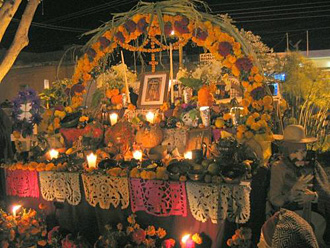 |
 |
 |
 Vallarta Living | October 2007 Vallarta Living | October 2007  
Day of Dead Keeps Indigenous Roots in Rural Mexico
 Dora Alicia Rascon - Salinas Californian Dora Alicia Rascon - Salinas Californian
go to original


| | In Oaxaca the Day of the Dead is one of the most important celebrations of the year. Oaxacans set up altars like this in their homes in remembrance of deceased family members. (Suzanne Barbezat) |
On Nov. 1 and 2, Mexico and other Latin American countries celebrate the Day of the Dead.

This is one of the most interesting holidays of the Mexican culture, both in its origin and its meaning. The Day of the Dead is also one of the most colorful fiestas and a popular tourist attraction.

Nov. 1 is dedicated to dead children and Nov. 2 is dedicated to dead adults. The Day of the Dead is celebrated nationwide in Mexico. Schools, government offices and banks close. Although the day has an undoubtedly religious tone, it is a public holiday because it is considered to be an important part of our cultural heritage.

Some regions of Mexico hold artistic contests for posters, poetry or short stories; festivals of dance and lectures about the significance of death.

The core of the celebration is the belief, especially among indigenous people, that the souls of loved ones who have passed on return each year to pay a visit to the living world. The relatives prepare ahead all they will need to receive the souls with a big fiesta.

Mesoamerican Indians celebrated death more than 1,000 years before the Spanish arrived in America. Indians had two months dedicated to honoring the dead. When the Spanish arrived they were shocked by what they considered a pagan ritual and attempted by many means to eradicate it, but did not succeed.

When it was impossible to convince the Indians to do away with the celebration as it was, the Spanish agreed with the Indians to move the fest to the first and second days of November, when the Spanish remembered their dead. This is how the Day of the Dead celebration became the holiday as it is known today: a festivity with a mixture of Catholic and indigenous characteristics.

Nowadays, Mexicans have different ways of honoring the dead. Some people go to Mass, some go to cemeteries to clean graves and take flowers, and others set up altars in the house. But in regions with a larger Indian population - such as Oaxaca, Michoacán, Hidalgo, Chiapas and Estado de Mexico - the celebration keeps more of its original features.

In these places, people go to the cemetery, clean the graves, place candles, water, food, salt, flowers and some of the favorite belongings of the dead. They stay at the cemetery all night. Although the indigenous people eat the food they prepared for the dead, they believe that food does not have any nutritional value, as it has been "absorbed" by souls as they visit the living world.

All the things that are placed on the altar or on the graves are called "ofrenda" - "what it is offered." Either the altar or the grave must have a sample of the four natural elements: fire, water, earth and air, represented by the objects placed on them. Each of the objects signifies something special:

• A crucifix or any other Catholic image represents faith.

• Water is offered to quench souls' thirst and as a purifying element.

• Salt is another purifying element.

• Flowers, an earthly element, represent both joyfulness and the brevity of life.

• Food is an important offering because it is thought the soul must be hungry after the journey to this world. Usually, family members place a sample of everything the dead enjoyed when alive. Food also represents the element earth.

• Personal belongings are intended to make the soul feel comfortable in the living world as well as being able to recognize the world left behind.

• Copal, a resinous wood with a soft, agreeable scent, is used to perfume the air and to keep away bad spirits. In modern times, incense has been substituted for copal. Along with candles, copal and incense represent the element fire.

• "Bread of the dead" is a special baked good said to represent the soul of the dead.

• Candles illuminate the path to the altar.

• Paper of different colors represents air. Each color has a special meaning. Black and purple symbolize grief, according to Catholic tradition; orange, grief for ancient Indians; yellow symbolizes brightness, the sunlight; white, purity; red, the blood of Christ, according to the Catholic Church; blue and bright pink are fiesta colors.

Dora Alicia Rascon of Michoacán, Mexico, teaches middle school in Greenfield by way of a state teacher-exchange program. Contact her by email at: rascon3589@yahoo.com. | 
 | |
 |



